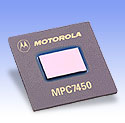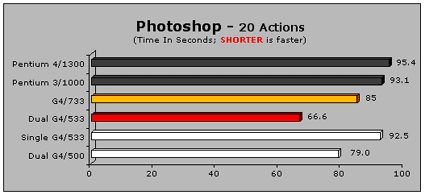Mensen die over de Pentium 4 vs. Athlon discussie nadenken op een meer beschaafde manier dan SoR zullen dit artikel van Ace's Hardware over de Pentium 4 zeker interessant vinden. Er worden hier namelijk geen Quake3 rondjes gedraaid, maar de drie belangrijkste onderdelen van de core (ALU, FPU en branch predictor) worden individueel en uitgebreid bekeken. Daardoor komen een aantal interessante punten aan het licht die de relatief lage performance van de chip in sommige situaties kunnen verklaren en ook waarom hij op andere punten uitblinkt.
Uiteindelijk moet men tot de conclusie komen dat de huidige standaardbenchmarks niet geschikt zijn om een goed beeld van de processor te vormen. Moderne compilers kunnen er wel eens voor gaan zorgen dat de P7 architectuur in de toekomst een stuk sterker blijkt te zijn dan met tot nu toe in reviews moest concluderen. Doormiddel van een simpele recompile (dus geen SSE2 implementatie in assembler, hoewel dat natuurlijk ook geen kwaad kan ![]() ) zou uit de Pentium 4 namelijk wel eens een flinke hoeveelheid extra snelheid gesleept kunnen worden. Hoeveel dat precies scheelt is men op dit moment aan het uitzoeken en zodra er een conclusie getrokken kan worden zal er een volgend deel verschijnen:
) zou uit de Pentium 4 namelijk wel eens een flinke hoeveelheid extra snelheid gesleept kunnen worden. Hoeveel dat precies scheelt is men op dit moment aan het uitzoeken en zodra er een conclusie getrokken kan worden zal er een volgend deel verschijnen:
I'm glad you were able to work through all the tech talk, as this is the most important part of the whole article. What contribution to our understanding of the Pentium 4 vs Athlon debate can these results possibly make? As you know, most FPU intensive benchmarks and Integer intensive benchmarks run faster on the Athlon 1200 (with DDR SDRAM). Our "code-sample" benchmarks proved this once again. Still, Intel is able to slap AMD's flagship silly in SpecInt and SpecFP.
[...] Yes, the SpecFP benchmark is more constrained by memory bandwidth than typical PC applications, and behaves more like its brother Spec ViewPerf, but does that mean that the Pentium 4 can only shine in bandwidth intensive applications? What about the fourth reason we listed above? Is it possible that the way that today's applications are compiled violate many important rules (see the optimization guide) of modern superscalar out of order CPUs and that those violations hurt the Pentium 4 more than the Athlon? We'll save that part of the discussion for next time.
 |
Lees het hele artikel met alle benchmarks en uitleg hier.

 Realistically, the verdict is still out....but the numbers so far do look bad. All
of the information we've seen on the PPC 7450 suggests that the added
processing units, better data paths, and on-chip full-speed L2 cache should
offest the deeper pipelines which are designed to trade off raw performance
for higher clock rates. The 7450 should -- and this is backed up entirely by
Motorola and Apple sources who have never had trouble calling their
employers on hiding problems or flaws -- perform better than the 7400/7410
at the same clock rate for some operations (Altivec, Integer) and only slighly
slower for others (Floating Point math, gaming) -- under no circumstances
should it be having trouble competing with 533MHz 7400s, which according
to some of the benchmarks coming out these days it is.
Realistically, the verdict is still out....but the numbers so far do look bad. All
of the information we've seen on the PPC 7450 suggests that the added
processing units, better data paths, and on-chip full-speed L2 cache should
offest the deeper pipelines which are designed to trade off raw performance
for higher clock rates. The 7450 should -- and this is backed up entirely by
Motorola and Apple sources who have never had trouble calling their
employers on hiding problems or flaws -- perform better than the 7400/7410
at the same clock rate for some operations (Altivec, Integer) and only slighly
slower for others (Floating Point math, gaming) -- under no circumstances
should it be having trouble competing with 533MHz 7400s, which according
to some of the benchmarks coming out these days it is.


 "We believe we are the first ones out who can get a high yield at
266A, and the feedback we are getting is that our 266A is leading the
pack," he said.
"We believe we are the first ones out who can get a high yield at
266A, and the feedback we are getting is that our 266A is leading the
pack," he said.
 In an effort to deliver high-performance, feature-rich graphics processing unit (GPU) capabilities to every end-user, NVIDIA® Corporation (Nasdaq: NVDA - news) today unveiled the GeForce2 MX 200 and 400 GPUs. Featuring the 256-bit core technology of the GeForce2 family, 64 and 128-bit memory interface, and various clock speeds - this family of GPUs brings high-performance desktop GPU performance and capabilities to the value mainstream market.
In an effort to deliver high-performance, feature-rich graphics processing unit (GPU) capabilities to every end-user, NVIDIA® Corporation (Nasdaq: NVDA - news) today unveiled the GeForce2 MX 200 and 400 GPUs. Featuring the 256-bit core technology of the GeForce2 family, 64 and 128-bit memory interface, and various clock speeds - this family of GPUs brings high-performance desktop GPU performance and capabilities to the value mainstream market.

/i/991448252.png?f=thumbmedium)
:fill(white):strip_exif()/i/2000848898.jpeg?f=thumbmedium)
:fill(white):strip_exif()/i/2000848880.jpeg?f=thumbmedium)


 Owners of portable Macs also may experience some problems, including power-management issues affecting the OS' ability to awaken and go to sleep. Intermittent bugs affecting the sleep cycle may not be resolved by the time Cheetah reaches the so-called golden master, and the development team has not fully tested its stability on the newest Apple hardware, including the PowerBook G4 Titanium.
Owners of portable Macs also may experience some problems, including power-management issues affecting the OS' ability to awaken and go to sleep. Intermittent bugs affecting the sleep cycle may not be resolved by the time Cheetah reaches the so-called golden master, and the development team has not fully tested its stability on the newest Apple hardware, including the PowerBook G4 Titanium.
/i/1300972166.png?f=fpa)
 Actually, at this time ABIT will not be making a GF3 card. We are concerned about the high price and about the ability of nVidia to offer continued supply with their X-Box demands. We will look at producing such a card in the future when a greater number of applications and games will be able to make full use of the power of the nVidia GF3.
Actually, at this time ABIT will not be making a GF3 card. We are concerned about the high price and about the ability of nVidia to offer continued supply with their X-Box demands. We will look at producing such a card in the future when a greater number of applications and games will be able to make full use of the power of the nVidia GF3.
:strip_exif()/i/987929778.jpg?f=thumbmedium)